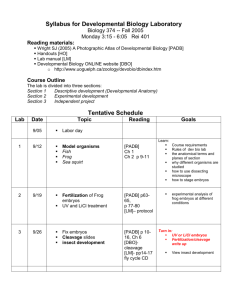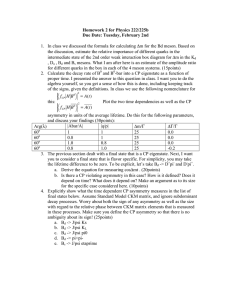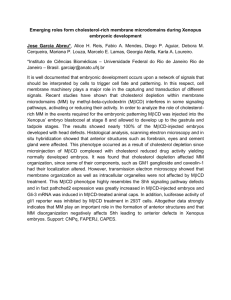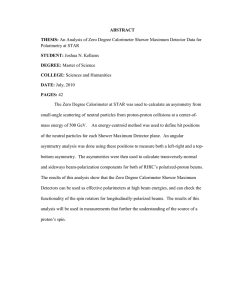Dispatch Left–right Asymmetry: All Hands to the Pump
advertisement
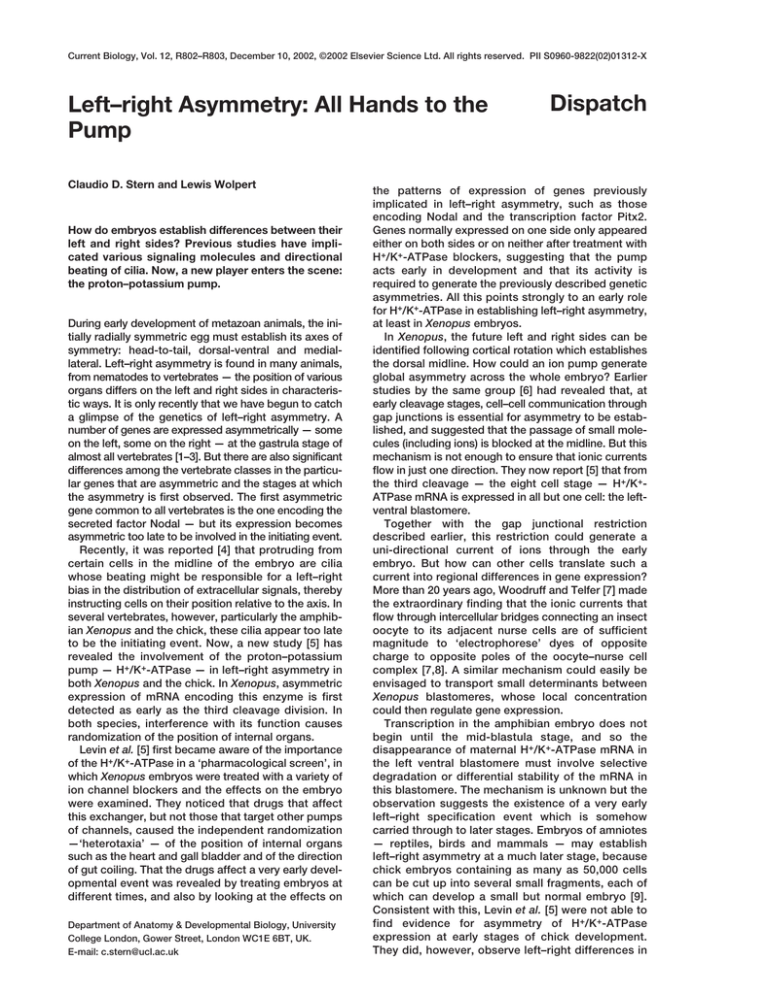
Current Biology, Vol. 12, R802–R803, December 10, 2002, ©2002 Elsevier Science Ltd. All rights reserved. PII S0960-9822(02)01312-X Left–right Asymmetry: All Hands to the Pump Claudio D. Stern and Lewis Wolpert How do embryos establish differences between their left and right sides? Previous studies have implicated various signaling molecules and directional beating of cilia. Now, a new player enters the scene: the proton–potassium pump. During early development of metazoan animals, the initially radially symmetric egg must establish its axes of symmetry: head-to-tail, dorsal-ventral and mediallateral. Left–right asymmetry is found in many animals, from nematodes to vertebrates — the position of various organs differs on the left and right sides in characteristic ways. It is only recently that we have begun to catch a glimpse of the genetics of left–right asymmetry. A number of genes are expressed asymmetrically — some on the left, some on the right — at the gastrula stage of almost all vertebrates [1–3]. But there are also significant differences among the vertebrate classes in the particular genes that are asymmetric and the stages at which the asymmetry is first observed. The first asymmetric gene common to all vertebrates is the one encoding the secreted factor Nodal — but its expression becomes asymmetric too late to be involved in the initiating event. Recently, it was reported [4] that protruding from certain cells in the midline of the embryo are cilia whose beating might be responsible for a left–right bias in the distribution of extracellular signals, thereby instructing cells on their position relative to the axis. In several vertebrates, however, particularly the amphibian Xenopus and the chick, these cilia appear too late to be the initiating event. Now, a new study [5] has revealed the involvement of the proton–potassium pump — H+/K+-ATPase — in left–right asymmetry in both Xenopus and the chick. In Xenopus, asymmetric expression of mRNA encoding this enzyme is first detected as early as the third cleavage division. In both species, interference with its function causes randomization of the position of internal organs. Levin et al. [5] first became aware of the importance of the H+/K+-ATPase in a ‘pharmacological screen’, in which Xenopus embryos were treated with a variety of ion channel blockers and the effects on the embryo were examined. They noticed that drugs that affect this exchanger, but not those that target other pumps of channels, caused the independent randomization —‘heterotaxia’ — of the position of internal organs such as the heart and gall bladder and of the direction of gut coiling. That the drugs affect a very early developmental event was revealed by treating embryos at different times, and also by looking at the effects on Department of Anatomy & Developmental Biology, University College London, Gower Street, London WC1E 6BT, UK. E-mail: c.stern@ucl.ac.uk Dispatch the patterns of expression of genes previously implicated in left–right asymmetry, such as those encoding Nodal and the transcription factor Pitx2. Genes normally expressed on one side only appeared either on both sides or on neither after treatment with H+/K+-ATPase blockers, suggesting that the pump acts early in development and that its activity is required to generate the previously described genetic asymmetries. All this points strongly to an early role for H+/K+-ATPase in establishing left–right asymmetry, at least in Xenopus embryos. In Xenopus, the future left and right sides can be identified following cortical rotation which establishes the dorsal midline. How could an ion pump generate global asymmetry across the whole embryo? Earlier studies by the same group [6] had revealed that, at early cleavage stages, cell–cell communication through gap junctions is essential for asymmetry to be established, and suggested that the passage of small molecules (including ions) is blocked at the midline. But this mechanism is not enough to ensure that ionic currents flow in just one direction. They now report [5] that from the third cleavage — the eight cell stage — H+/K+ATPase mRNA is expressed in all but one cell: the leftventral blastomere. Together with the gap junctional restriction described earlier, this restriction could generate a uni-directional current of ions through the early embryo. But how can other cells translate such a current into regional differences in gene expression? More than 20 years ago, Woodruff and Telfer [7] made the extraordinary finding that the ionic currents that flow through intercellular bridges connecting an insect oocyte to its adjacent nurse cells are of sufficient magnitude to ‘electrophorese’ dyes of opposite charge to opposite poles of the oocyte–nurse cell complex [7,8]. A similar mechanism could easily be envisaged to transport small determinants between Xenopus blastomeres, whose local concentration could then regulate gene expression. Transcription in the amphibian embryo does not begin until the mid-blastula stage, and so the disappearance of maternal H+/K+-ATPase mRNA in the left ventral blastomere must involve selective degradation or differential stability of the mRNA in this blastomere. The mechanism is unknown but the observation suggests the existence of a very early left–right specification event which is somehow carried through to later stages. Embryos of amniotes — reptiles, birds and mammals — may establish left–right asymmetry at a much later stage, because chick embryos containing as many as 50,000 cells can be cut up into several small fragments, each of which can develop a small but normal embryo [9]. Consistent with this, Levin et al. [5] were not able to find evidence for asymmetry of H+/K+-ATPase expression at early stages of chick development. They did, however, observe left–right differences in Current Biology R803 resting potential of the cells. They found these differences are sensitive to H+/K+-ATPase blockers; as in amphibians, these blockers also cause heterotaxia in chick embryos. But the authors [5] also recognize that H+/K+-ATPase localization, even in amphibian embryos, cannot be the initiating event. Something must specify the left-ventral blastomere as different from its right-ventral neighbor, so that H+/K+-ATPase mRNA is degraded from the former and not the latter. Another puzzle is that misexpression of the H+/K+-ATPase along with the cooperating K+ channel Kir4.1 only causes heterotaxia in Xenopus if the mRNA is injected at the one-cell stage, while embryos remain sensitive to blockers of this pump until mid-blastula (stage 8) [5]. It is possible, however, that the injected RNA lacks untranslated sequences required for differential localization, stability or selective degradation. It is also a mystery that, while embryos lose their sensitivity to H+/K+-ATPase antagonists at stage 8, this is still long before the first known gene is expressed asymmetrically. In the chick, by contrast, the left–right differences in membrane potential seem to appear at the mid-primitive streak stage [4], by which time the earliest asymmetric gene — cActRIIA which encodes the ‘activin’ receptor — is already expressed on the right side [1,10]. An early model for the origin of left–right asymmetry remains very attractive. Brown and Wolpert [11] suggested that each cell might contain a molecule with intrinsic handedness — for example, ‘F’-shaped — which would confer left–right polarity to the cell as long as its localization is fixed with respect to the other axes. The cilia described recently in mouse and other embryos [4,12] fit this model perfectly in that they are localized only apically in the cells, and their direction of beating is determined by the intrinsic structure of the motor protein left–right dynein [13]. As mentioned above, however, cilia would seem to develop too late in development to be the initiating mechanism. Another major unresolved problem is that at present no mechanism is known that can ensure that left–right information is transmitted along the entire head-to-tail extent of the embryonic axis. The head-tail axis is established by a progressive mechanism involving timing and probably the sequential allocation of positional identity to the progeny of stem cells in the mesoderm and nervous system [14,15], which occurs over a protracted period that starts long after these early stages. During this period, the current members of the genetic cascade involved in left–right asymmetry are confined to the node/blastopore and its immediate neighborhood and we do not understand what mechanisms might, for example, be responsible for directing the turning of the gut or localising the pancreas or gall bladder to the left and right sides, respectively. Like many other landmarks in science, the new paper of Levin et al. [5] is very provocative, but does not quite provide all the answers. It is evident that many important features of left–right development remain unknown and that our interest in solving this fascinating problem will remain as lively as it is now for some time to come. References 1. Levin, M.J., Johnson, R.L., Stern, C.D., Kuehn, M. and Tabin, C. (1995). A molecular pathway determining left–right asymmetry in chick embryogenesis. Cell 82, 803–814. 2. Wright, C.V. (2001). Mechanisms of left–right asymmetry: what’s wright and what’s left? Dev. Cell 1, 179–186. 3. Capdevila, I. and Izpisua-Belmonte, J.C. (2000). Knowing left from right: the molecular basis of laterality defects. Mol. Med. Today 6, 112–118. 4. Nonaka, S., Shiratori, H., Saijoh, Y. and Hamada, H. (2002). Determination of left–right patterning of the mouse embryo by artificial nodal flow. Nature 418, 96–99. 5. Levin, M., Thorlin, T., Robinson, K., Nogi, T. and Mercola, M. (2002). Asymmetries in H+/K+-ATPase and cell membrane potentials comprise a very early step in left–right patterning. Cell 111, 77-89. 6. Levin, M. and Mercola, M. (1998). Gap junctions are involved in the early generation of left–right asymmetry. Dev Biol 203, 90-105. 7. Woodruff, R.I. and Telfer, W.H. (1980). Electrophoresis of proteins in intercellular bridges. Nature 286, 84–86. 8. Jaffe, L.F. (1981). The role of ionic currents in establishing developmental pattern. Philos. Trans. R. Soc. Lond. B Biol. Sci. 295, 553–566. 9. Spratt, N.T. and Haas, H. (1960). Integrative mechanisms in development of the early chick blastoderm. I. Regulative potentiality of separated parts. J. Exp. Zool. 145, 97–137. 10. Stern, C.D., Yu, R.T., Kakizuka, A., Kintner, C.R., Mathews, L.S., Vale, W.W., Evans, R.M. and Umesono, K. (1995). Activin and its receptors during gastrulation and the later phases of mesoderm development in the chick embryo. Dev. Biol. 172, 192–205. 11. Brown, N.A. and Wolpert, L. (1990). The development of handedness in left/right asymmetry. Development 109, 1–9. 12. Essner, J.J., Vogan, K.J., Wagner, M.K., Tabin, C.J., Yost, H.J. and Brueckner, M. (2002). Conserved function for embryonic nodal cilia. Nature 418, 37–38. 13. Supp, D.M., Witte, D.P., Potter, S.S. and Brueckner, M. (1997). Mutation of an axonemal dynein affects left–right asymmetry in inversus viscerum mice. Nature 389, 963–966. 14. Vasiliauskas, D. and Stern, C.D. (2001). Patterning the embryonic axis: FGF signaling and how vertebrate embryos measure time. Cell 106, 133–136. 15. Stern, C.D., Hatada, Y., Selleck, M.A. and Storey, K.G. (1992). Relationships between mesoderm induction and the embryonic axes in chick and frog embryos. Dev. Suppl. 151–156.

